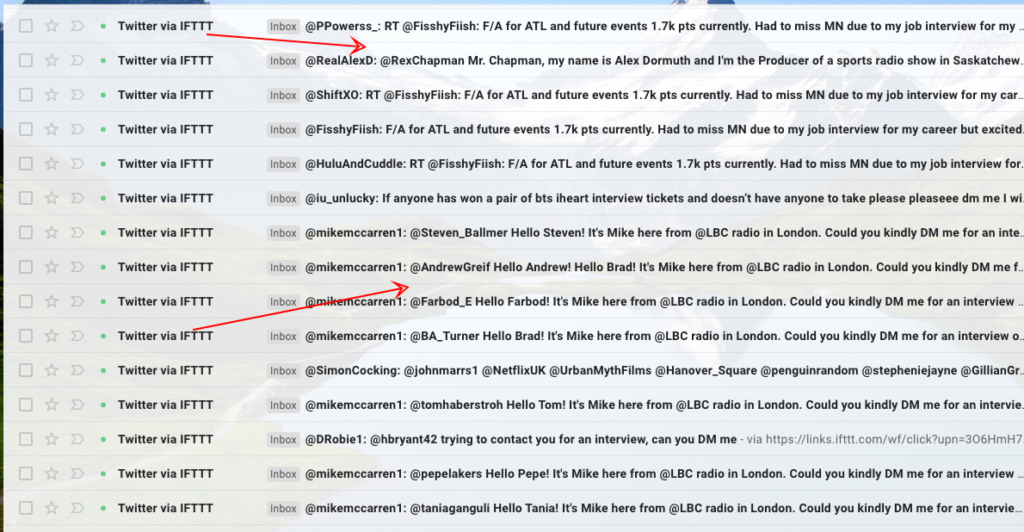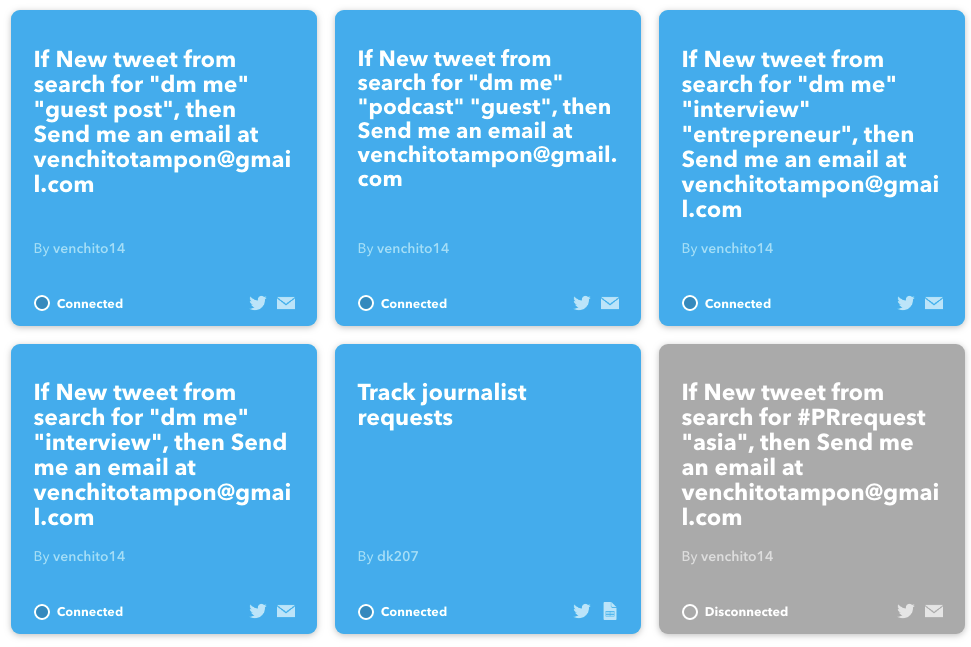by Venchito Tampon Jr | Last Updated on November 13, 2021
Social media platforms have been useful places to promote the brand’s content.
Certainly, this includes the idea of using Twitter effectively to build connections with like-minded people, to get more eyeballs to content, and to acquire natural links in the process.
You don’t use Twitter to spam people with links to your content, all the time. There is a proper way of sharing your content on the platform, and be mindful of being too aggressive just for the sake of links. That 2009 strategy doesn’t work anymore.
How to Use Twitter Effectively For Link Building
Here are four useful tips on how to use Twitter for link building and content marketing campaigns:
- Experiment with Tweetstorms
- Look for Interview Requests
- Take advantage of Twitter chats
- Build Stronger Networks
1. Experiment with Tweetstorms
If you’re a marketer or business person, you may have seen threads of tweets of famous founders — these are tweetstorms.
Tweetstorm is a thread of tweets conveying messages, principles, ideas, stories, or trends. In any topic area, a tweetstorm can be a powerful way to drive more followers to your brand.
Specific to link building, you can gain new connections you can eventually reach out to for potential content contributions or content collaborations.
It’s a subtle approach of building your influence around a platform that sticks.
Here are some examples of the best tweetstorms.
Ben Collins on Google Sheets Productivity
Mega thread of #GoogleSheets #productivity tips & tricks coming up…
Starting with this humdinger
Type “https://t.co/AowcjCD40h” or “https://t.co/kOOFaQOOov” into your browser to instantly create a new Google Sheet
(1/n) pic.twitter.com/TvB5cUk15D
— Ben Collins (@benlcollins) January 14, 2020
Why it worked:
- It starts with a topic idea “mega-thread of Google sheets productivity”. This sets the foundation and know-how to people who’d likely follow all tweets in that thread. This gives people the general context of the tweetstorm.
- It includes hashtags to gain more visibility searching for it (#GoogleSheets and #Productivity).
- It contains visual formats (e.g. gifs).
- It provides actionable takeaways for each tweet in the tweetstorm.
Jensen Harris on Loving Startup
Leaving a big company job for a startup can rejuvenate your career and make you love work again.?
But landing a startup job requires relearning some things, especially if (like me) you logged years and years at Microgoogfaceforceazon.
Here are six things I wish I’d known:
— Jensen Harris (@jensenharris) April 12, 2018
Why it worked:
- His career tips are based on his experiences (things I wish I’d known).
- It gives straight a context to which audience the tweetstorm is for.
- He answers to every reply to tweets in the tweetstorm — giving more visibility to the entire tweetstorm; attracting more replies and retweets.
How to use tweetstorms in gaining traction for links:
- Brainstorm on what topic idea works best in a tweetstorm — it should be something interesting, either it is a story, concept, or how-to steps (quickly be narrated in a tweetstorm).
- Be subtle in adding links to your content. Link to your page as long as the tweet or a reply to tweet replies make sense in the context.
- Hooks the people to see your other tweets by making your first tweet cuts the deepest. Your first tweet should also work as a singular message.
- Share relevant links to your content as separate tweets after a tweetstorm. New followers from tweetstorms would likely see and consume your content — which results in more social shares and links to your page.
2. Look for Interview Requests
There are many methodologies for getting more exposure to high-end industry publications.
You can get your articles published in major niche websites, use HARO effectively for interview or story requests, or approach journalists using Twitter.
For months, I’ve been tracking requests from bloggers, content creators, journalists, and other publishers who are looking for stories and guests for their show (e.g. podcasts).
Here’s what it looks like in my inbox:

I keep track of all these emails from IFTTT, which is a setup that I’ve created to easily automate looking to interview tweets from publishers.

IFTTT allows you to create applets or recipes that trigger whenever there are tweets with (#prrequest OR #journorequest OR #haro). These tweets are sent to your inbox, which is often frequent so you need to have a filtering process to remove irrelevant tweets (looking to interview tweets not relevant to your niche).
Additional tips to use Twitter effectively in gaining new interview invitations (for links):
- Share your content pieces regularly on Twitter. It helps in gaining visibility for your brand to attract publishers and other media creators, such as podcasters, to invite you to their shows.
- Promote your latest interviews (media interviews, podcast guestings, round-up articles where you share your best inputs).
- Create private Twitter lists of major and minor publishers in your industry. Keep track of what they do by monitoring their tweets — you may never know moments they’d post tweets looking for interviewees.
3. Take advantage of Twitter chats
Twitter chats are scheduled group discussions on a particular topic, normally with guest experts to answer a series of questions.
In the digital marketing field, you’ll see a good share of these Twitter chats every week.
SEMRush does this well.
Q1. You created content that didn’t meet goals. How do you explain this to clients or the c-suite? Next steps? @CTrappe #SEMrushChat pic.twitter.com/Pql6Ipz2CM
— SEMrush (@semrush) January 22, 2020
Why it worked:
- Scheduled activities are likely to be included in someone’s calendar. This allows people to regularly attend to your Twitter chats — and even share it with their own networks if they find it worthy of their time.
- Invite guests to your Twitter chats to get a ripple effect in social sharing. Interviewees will normally promote their scheduled Twitter chat to their followers — this gives chances of gaining new traction to your show.
- Have a list of questions ready to answer. Invited guests will then know what to do during Twitter shows, as opposed to randomly asking them with anything.
4. Build Stronger Networks
Be very subtle in your approach to Twitter marketing.
Use Twitter to expand your networks.
One recommended approach is to customize your tweets when sharing useful content in your niche.
Analysis of 700,000 articles:
While long-form content may not be a ranking factor, it sure gets shared/linked-to at a higher rate (& anecdotally, tends to rank for more terms)
Anatomy of Top Performing Articles https://t.co/unfsnpzwyO
thx @Kevin_Indig for the tip. via @semrush pic.twitter.com/gwZAG8NOzX
— Cyrus (@CyrusShepard) January 15, 2020
Instead of following paths of basic tweet lines to content.
When you’ve actually read the content piece, you know its best points. So start sharing what you learned from the content and highlight them in your tweets.
This initiative helps you to stand out among people who shared tweets, which increases your chances to be on the radar for your brand to be noticed by the original content creator.
How to build stronger networks using Twitter:
- Regularly share the best content pieces in your industry. It only takes 3 to 5 minutes to do this when scheduling posts — you can use Buffer for Twitter scheduling.
- Start participating in threads where you think you can add value with your inputs. Engage people with your expertise.
- Create your own Twitter list to follow influencers in your industry. This method also allows you to generate ideas for your content, as you’re able to see what types and topics of content your influencers (who are likely to link to your site) are actively sharing on Twitter.
Learning How to Use Twitter Effectively
Follow the basic principles and tips I’ve shared above then experiment on new ways on how you can maximize Twitter in marketing your business. Let me know in the comment section below if you have any questions.
The Author
Venchito Tampon Jr
Venchito Tampon is a Filipino Motivational Speaker, Corporate Trainer, and a Leadership Speaker in the Philippines. He is the CEO and Co-Founder of SharpRocket, a link building agency. With a decade of experience, Venchito has a proven track record of leading hundreds of successful SEO (link builidng) campaigns across competitive industries like finance, B2B, legal, and SaaS. His expert advice as a link building expert has been featured in renowned publications such as Semrush, Ahrefs, Huffington Post and Forbes. He is also an international SEO spoken and has delivered talks in SEO Zraz, Asia Pacific Affiliate Summit in Singapore, and Search Marketing Summit in Sydney, Australia. Check out his other businesses, Hills & Valleys Cafe, Blend N Sips and Saas Pursuit.
How our LINK BUILDING AGENCY builds 250 links/mo consistently using Predictable Link Building Methodology™…
- Using a SIMPLE and PROVEN system
- Using a SCALABLE strategy
- No private blog networks
- No creepy outreach emails
